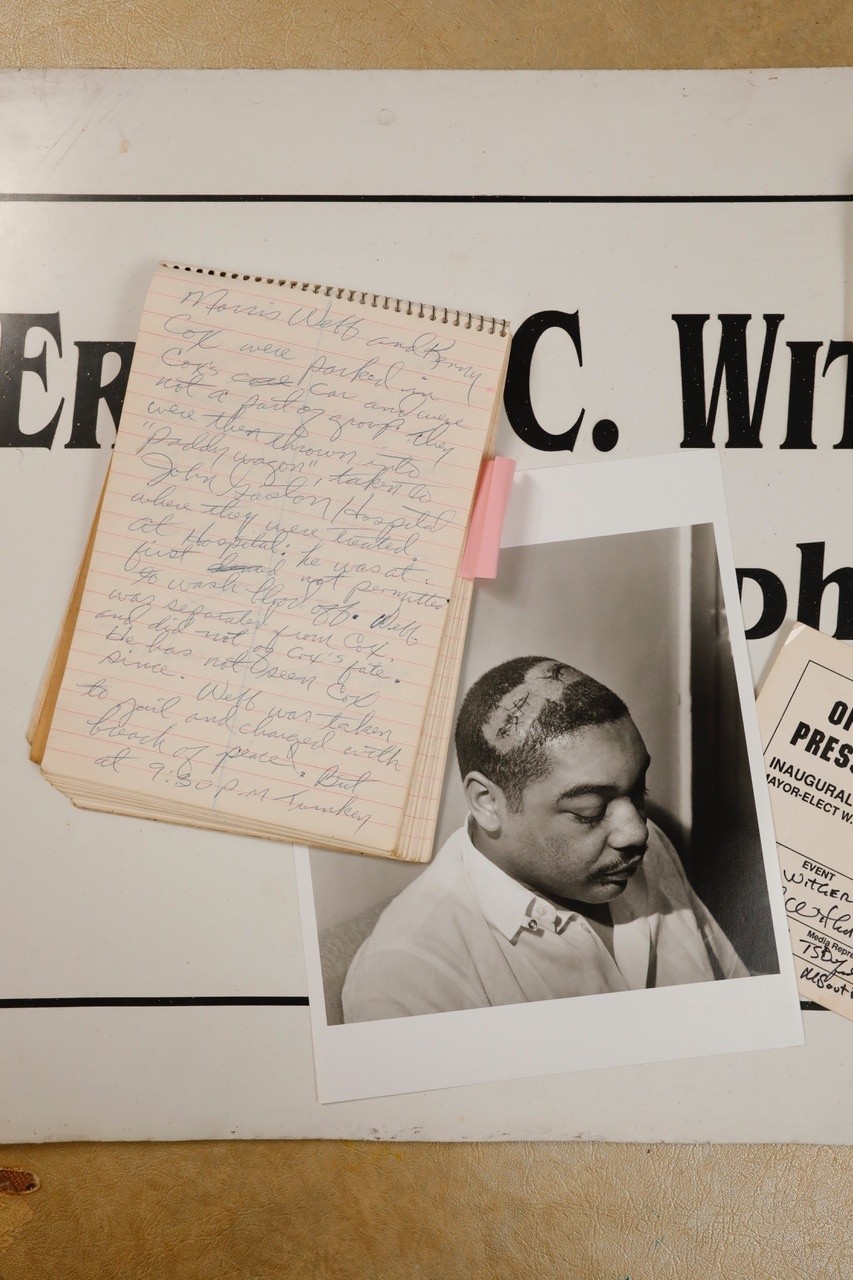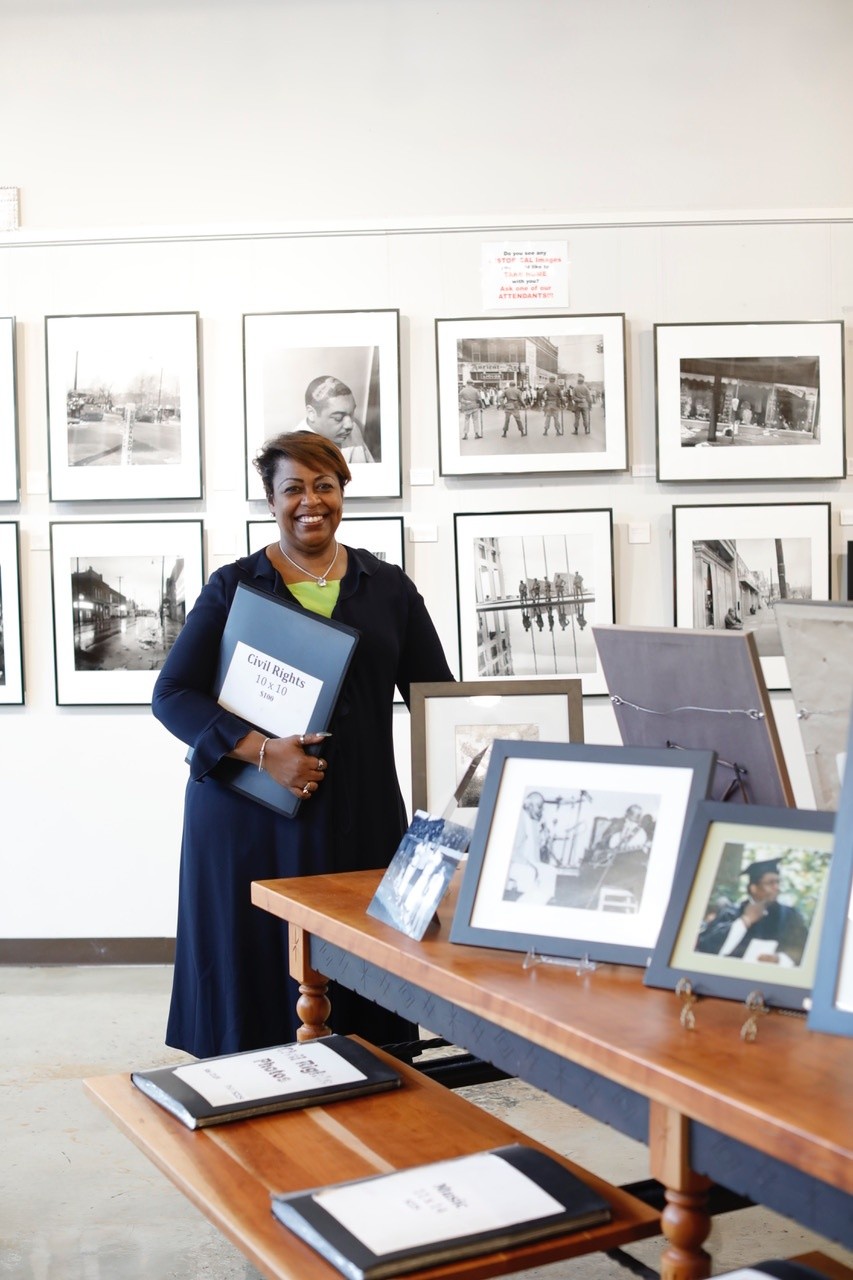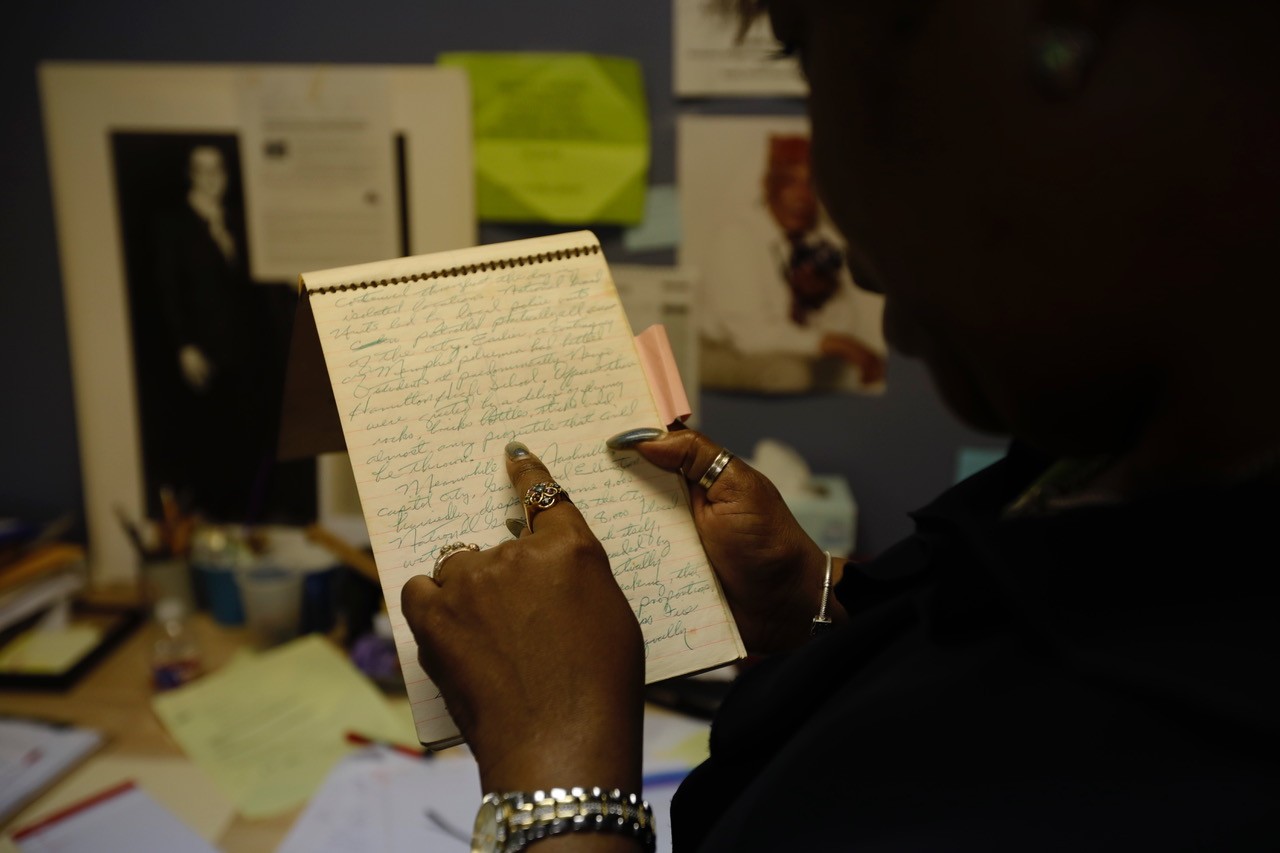 Justin Fox Burks
Justin Fox Burks
The Withers Family Trust, which manages half a century’s worth of documents, prints, and negatives produced by renowned photographer Ernest Withers, was abuzz with excitement last week over an artifact that most historians would consider buried treasure.
The trust’s archives, containing an estimated 1.8 million negatives and prints, largely uncatalogued, are still in the throes of an exhaustive reorganization led by program manager Carol McCarley.
The many hundreds of boxes still hold plenty of surprises for the archive’s staff, as when, last Wednesday, an unassuming stenographic notebook was found.
“It was just odd, yesterday being the 28th, and we uncovered this,” McCarley said the following day, holding up the notebook. “It was around 11:45 in the morning. I picked it up and flipped it open and it said, ‘On Thurs. March 28, at approx. 11:45am, the march on city hall…’ I kept reading and reading. And I thought, ‘Wow, that’d be exactly 50 years ago today. Oh my goodness!’”
“It gave me shivers,” added Rosalind Withers, CEO at the Withers Collection Museum & Gallery.
 Justin Fox Burks
Justin Fox Burks
While nearly all the materials in the archives were created in the course of Withers’ photographic work, there was some doubt as to whether he had written the eyewitness reports. In the notebook’s end pages, there are lists of photos, identifying the subjects, and notes concerning photos sent to the St. Louis Sentinel, at a charge of $10 per image (the equivalent of over $70 today).
Presumably these are Withers’ own notes. But the front of the notebook, detailing events as they transpired half a century ago, appears to be the work of another.
“We did question the handwriting,” said McCarley. Added Rosalind, “Yeah, it didn’t look like dad’s. It’s not dad. (The author) mentions dad in the writing.”
In fact, the bulk of the notebook appears to be a professional reporter’s hurriedly edited eyewitness notes from the Sanitation Workers’ Strike that unfolded on that day.
Judging from the attention paid to the racial antagonism of the police officers, and certain comments from the officers, the reporter was likely a member of the African-American press.
The following excerpt speaks for itself as a time capsule from that historic day:
“The Martin King March
On Thurs. March 28, at approx. 11:45am, the march on city hall by striking city sanitation workers left Clayborn Temple at Ponotoc and Hernando. A confrontation with the mayor of Memphis, Henry Loeb, was the goal of the Marchers. In from Atlanta Georgia, to lead the march was the Rev. Dr. Martin Luther King.
[pullquote-7] The procession, which was never orderly and not quite really organized, had gone 4½ blocks when chaos and disorder erupted.
At 3:24, five squad cars regular and unmarked left Beale & Hernando at high rate of speed and proceeded south on Hernando. At this time I was queried by a policeman who wanted to know if the writing of biased news was my reason for being present.
The hurried arrival and departure of police cars continued frequently throughout the day.
 Justin Fox Burks
Justin Fox Burks
Field Command Post was set up at this location from which police dispatched and to various areas of the city.
At 12:35, Larry Payne 16 year old student at Mitchell High School was shot and killed by three white policemen, allegedly after turning on them with knife. Police charged Payne had looted a retail store nearly three blocks away.
[pullquote-2] As violence and disorder continued throughout the day in isolated locations, National Guard Units led by local police units patrolled practically all areas of the city. Earlier, a contingency of Memphis policemen had battled students at predominantly Negro Hamilton High School. Officers there were greeted by a deluge of flying rocks, bricks, bottles, sticks, and almost any projectile that could be thrown.
Meanwhile in Nashville, the capitol city, Gov. Buford Ellington hurriedly dispatched some 4,000 National Guardsmen into the city with an additional 8,000 placed on standby. The March itself, led by Dr. King was proceeded by about 300 youths who actually started the window breaking, that grew into violent and riot proportions. Crews of Memphis Fire Department were kept equally busy.
At the height of disorder on Main Street, Dr. King was hurriedly whisked away to an undisclosed destination presumably for further strategy planning. Elements of the Black Power movement were not known to have had an active participation in riot. City officials believe started trouble because they were angered by the turn-around in the march.
[pullquote-1] A negro copy clerk for the Commercial Appeal (one of two dailies that has supported the Mayor) was told to move on by a policeman. The youth said: “I am with the press.” The policeman sprayed him with Mace.
The white press was allowed to move freely without interference. Negro press members were hampered and their movements restricted every block they advanced. Veteran Negro newsman and press photographer Ernest C. Withers was stopped at every corner and had to get clearance from a white police inspector before he was allowed to move.
One policeman hit a small boy – about 8 or 9 years old with a baton on the back and leg as the boy walked past the policeman. One policeman asked this observer if it were my intention to write biased news for the Negro press.
[pullquote-4] “Our cause is love Our cause is just Our cause is right We did the only thing we could, protest indignity” – Rev. C. M. Lee
Starks: “Weapons in hands of police were not riot control weapons but kill weapons”
Harold Whalum [&] Tillie Whalum of 1775 Glenview: Union Protective [Insurance]: Whalum was attempting to help Jim Lawson reverse March. Mr. Whalum was joined by Jesse Turner in restoring order on Main St. When they reached Beale Street. Mr. Whalum tried to restrain a group of youngsters from engaging. Entered NAACP building at 234 Hernando.
One officer entered building and shouted obscenities at a group of women. When Mr. Whalum protested he was attacked and was sprayed Mace, when he protested further. The officer’s partner leveled his shotgun at Mr. Whalum and screamed: “You black mother—— open your mouth once more.” At this point Mr. Whalum was restrained by Dr. Vasco Smith.
[pullquote-5] Mr. Whalum is also 1st Vice Chairman of Urban League Board, member of Traffic Advisory Committee and March of Dimes and President of Union Protective Insurance, Citizen’s Association, Chamber of Commerce, Welcoming Committee.
Morris Webb of 378 F Danny Thomas at Big M.
Police disbursed a group of loud youths at the Big M. Officers approached group and said “Let’s get out of here”. Someone in the crowd remarked, “We don’t have to go any damn where”. The officer in charge then told his partners “Let’s get these niggers out of here”. They then attacked the group and sprayed them with Mace.
Morris Webb and Kenny Cox were parked in Cox’s car and were not a part of group. They were then thrown into “paddy wagon”, taken to John Gaston Hospital where they were treated.
At hospital: he was at first not permitted to wash blood off. Webb was separated from Cox, and did not of Cox’s fate [sic]. He has not seen Cox since. Webb was taken to jail and charged with breach of peace. But at 9:30 p.m. Turnkey Ben Price told Webb that police had not placed charges against him. People with attorneys were heard first. The next morning before Judge Bernie Weinman dismissed disposition of breach of peace. 527-6918
Morris Webb stated that:
A man standing at Vance & Fourth witnessed 10 or 12 boys captured by police, it appeared obvious the boys were about to be beaten when a truck of National Guardsmen approached, the truck’s commander had his unit surround the policemen and proceeded to tell them the boys had been apprehended and no rough treatment was necessary. If they were going to arrest them, they should be arrested and not beaten up.”
[pullquote-6]